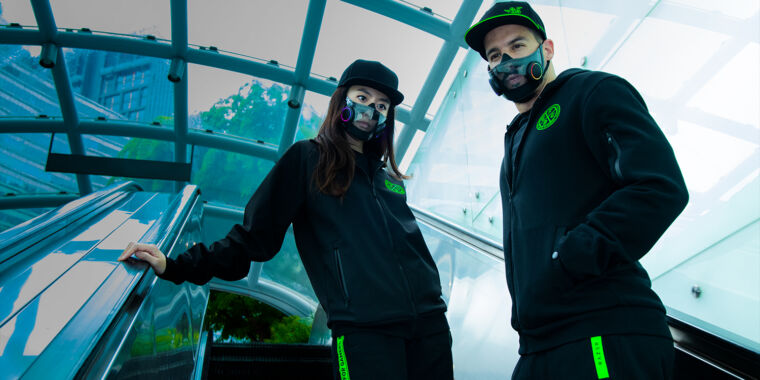
-
The Razer Project Hazel N95 mask concept.Razer
-
LED grid, customizable by users. While this mask wearer's mouth is visible, it's obscured somewhat by the mask's transparent plastic.
-
Another angle, seemingly posed to terrify everyone.Razer
-
Depending on the angle and lighting, the Project Hazel face mask seems to let a lot of light in.
-
Razer Project Hazel N95 mask on a pair of models, one of whom seems to be asking herself if she left the oven on before leaving home today.Razer
-
We're not sure if the white one is a 3D render or the real deal, as the only photos we've seen have included the black model.Razer
-
Storage case, meant for both recharging the ventilators and applying ultraviolent disinfectant to the slots.
-
Same case idea, now in white!
-
Let's close the case...
-
...which includes some status signage. This is the part of the reveal that has us most optimistic that this may be a real headset someday (albeit, not a cheap one).Razer
-
CGI highlight of silicon nose guard.
-
Voice augmentation, as boosted through at least one ventilation slot.
The annual deluge of CES gadgets and gizmos usually tries to predict what consumer-grade tech will look like in living rooms of the near future. But after a year like 2020, bendable TVs and surround-sound systems seem less interesting than a more pressing category: tech to help people go outside during an ongoing pandemic.
That's why we're taken by the Razer Project Hazel, arguably the most high-end face-mask concept we've seen since COVID-19 began ravaging the globe. This N95 mask concept was revealed as part of Razer's CES line of gamer-centric products on Tuesday, and it showed up as a surprise entry alongside the company's usual fare of laptops and gaming peripherals.
16.8 million colors on your face? Sure, why not
Razer's sales pitch alleges that this shouldn't be surprising at all, since the company repurposed at least one of its production lines to pump out over one million disposable, surgical-grade face masks in 2020. From there, someone at the company decided to go one further and make what looks like a fancypants, LED-smothered gamer mouse... for your face. Project Hazel immediately reinforces the company's affinity for customizable lighting grids, thanks to two rings of light—which support 16.8 million colors, because, why not—circling the mask's ventilation slots. We wouldn't be shocked if Razer eventually let gamers sync these light grids with nearby mice and keyboards.
After laughing about that aesthetic overkill, however, we generally nodded in agreement with Project Hazel's concept. The system, as advertised, would include an active ventilation system, whose slots fit into a recharging case that doubles as an ultraviolet disinfectant. A silicon guard would seal on users' cheeks and nose, while a voice-modulation system and a transparent plastic face would go the extra mile to maintain speech volume and visible mouths—things you absolutely won't find in a standard-issue cloth mask. Razer goes even further on guaranteeing your visible face by offering inside-facing lights as an option.
For now, Razer gets to hide behind the "concept" label. Without a live demo showing off exactly how it works, or any semblance of release date, price, or battery life on a single charge, Razer's concept could indeed be unachievable vaporware, or prohibitively expensive upon launch. Plus, there's the matter of fan-driven noise and battery-driven heat, both of which have to be distributed neatly to guarantee the Project Hazel sales pitch of comfortably leaving the mask on in public for long spans of time.
As an open-eye mask, Project Hazel is certainly less dramatic in construction than the likes of the Narwall Mask, an $85 option currently for sale that lacks active ventilation systems (or transparent face plate) and instead relies on a SCUBA-like, all-over design. (From a cursory glance, it looks like a great cosplay option for Snorks fans.) And as of press time, the best mask option we've found with transparent mouth windows, as part of our comprehensive mask buying guide, is trickier to recommend thanks to CDC guidelines. Even if Razer's prototype never emerges as a fully blown product, it's hard to imagine the rest of the international tech sector not moving forward with more ideas for how to safely navigate the outside world—well before COVID-19 vaccination becomes a social given. Should Razer send us any updates about Project Hazel becoming a retail product, we'll keep you posted.Listing image by Razer
Article From & Read More ( Razer’s N95: Voice boost, active ventilators, LED lights in mask prototype - Ars Technica )https://ift.tt/35zs0mN
Technology
Bagikan Berita Ini














0 Response to "Razer’s N95: Voice boost, active ventilators, LED lights in mask prototype - Ars Technica"
Post a Comment